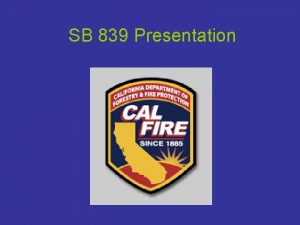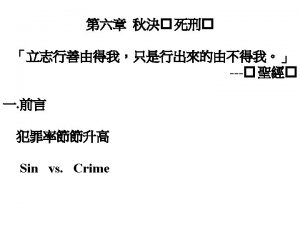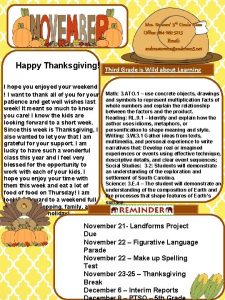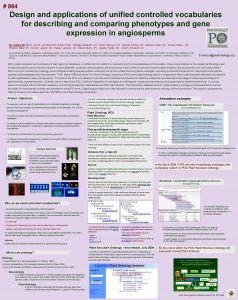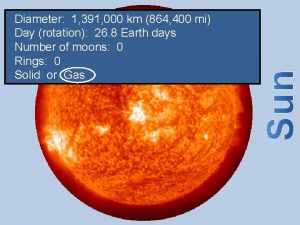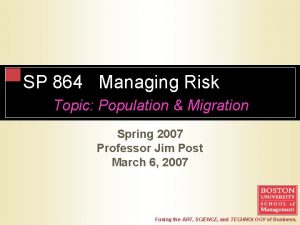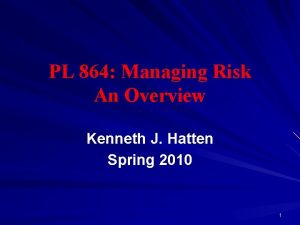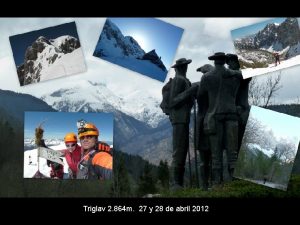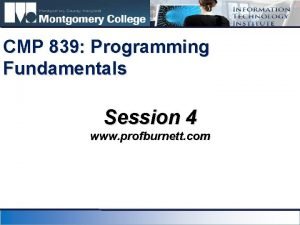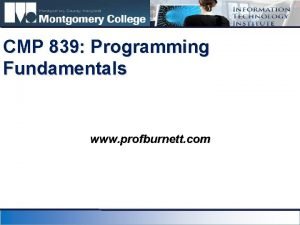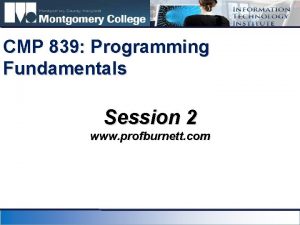Chapter 45 pp 839 864 Copyright The Mc


































- Slides: 34

Chapter 45: pp. 839 - 864 Copyright © The Mc. Graw-Hill Companies, Inc. Permission required for reproduction or display. 10 th Edition Sylvia S. Mader Community & Ecosystem Ecology BIOLOGY © B. Runk/S. Schoenberger/Grant Heilman Photography Power. Point® Lecture Slides are prepared by Dr. Isaac Barjis, Biology Instructor Copyright © The Mc. Graw Hill Companies Inc. Permission required for reproduction or display 1

Outline The Concept of the Community l The Structure of Communities l l l l Composition and Diversity Habitat and Ecological Niche Competition Between Populations Predator-Prey Interactions Symbiotic Relationships Island Biogeography Community Development l Ecological succession 2

Outline l The Nature of Ecosystems l l Energy Flow l l Abiotic Components Autotrophs Heterotrophs Ecological Pyramids Biogeochemical Cycles l l Hydrologic Cycle Carbon Cycle Nitrogen Cycle Phosphorus Cycle 3

Community Concept l. A community is an assemblage of populations interacting with one another within the same environment. The species composition (also called species richness) of a community is a listing of various species in the community. l Diversity includes both species richness and the abundance of different species. l 4

Community Structure Copyright © The Mc. Graw-Hill Companies, Inc. Permission required for reproduction or display. squirrel moose snowshoe hare bear red fox wolf a. kinkajou monkey anteater jaguar tapir bat sloth b. a(Forest): © Charlie Ott/Photo Researchers, Inc. ; a(Squirrel): © Stephen Dalton/Photo Researchers, Inc. ; a(Wolf): © Renee Lynn/Photo Researchers, Inc. ; b(Rain forest): © Michael Graybill and Jan Hodder/Biological Photo Service; b(Kinkajou): © Alan & Sandy Carey/Photo Researchers, Inc. ; b(Sloth): © Studio Carlo Dani/Animals Earth Scenes 5

Habitat and Ecological Niche l Habitat l l The area where an organism lives and reproduces Ecological niche l The role a species plays in its community l Includes its habitat, and l Its interactions with other organisms l Fundamental niche - All conditions under which the organism can survive l Realized niche - Set of conditions under which it exists in nature 6

Feeding Niches for Wading Birds Copyright © The Mc. Graw-Hill Companies, Inc. Permission required for reproduction or display. Flamingos feed on small molluscs, crustaceans, and vegetable matter strained from mud pumped through their bills by their powerful tongues. Dabbling ducks feed by tipping, tail up, to reach aquatic plants, seeds, snails, and insects. Avocets feed on insects, small marine invertebrates, and seeds by sweeping their bills from side to side in shallow water. Oystercatchers pry open bivalve shells with their knifelike bills and probe sand for worms and crabs. Plovers dart around on beaches and grasslands hunting for insects and small invertebrates. 7

Community Structure l Competition When two species compete, the abundance of both species is negatively impacted l Predation (or parasitism) l Expected to increase the abundance of the predator (or parasite) l And reduce the abundance of the prey (or host) l 8

Competition Between Populations l Competition occurs when l Members of different species require the same resource, and l The supply of the resource is limited 9

Competition Between Two Laboratory Populations of Paramecium Population Density P. caudatum grown separately Population Density P. aurelia grown separately Population Density Copyright © The Mc. Graw-Hill Companies, Inc. Permission required for reproduction or display. Both species grown together Time 10

Competition Between Populations l l Competitive Exclusion Principle l No two species can indefinitely occupy the same niche at the same time l Resource Partitioning decreases competition between species l Resource partitioning leads to niche specialization and less niche overlap between species Character Displacement l Characteristics tend to become more divergent when populations belong to the same community than when they are isolated l Competition and resource partitioning may lead to character displacement 11

Character Displacement in Finches on the Galápagos Islands Percent of Sample Copyright © The Mc. Graw-Hill Companies, Inc. Permission required for reproduction or display. 50 Species coexist on Abingdon, Bindloe, James, and Jervis Islands 30 10 small medium Beak Depth large G. fortis exists alone on Daphne Island 50 30 10 small 50 medium Beak Depth large G. fuliginosa exists alone on Crossman Island 30 10 small G. fuliginosa medium Beak Depth G. fortis large G. magnirostris 12

Niche Specialization Among Five Species of Coexisting Warblers Copyright © The Mc. Graw-Hill Companies, Inc. Permission required for reproduction or display. Cape May warbler Black-throated green warbler Bay-breasted warbler Blackburnian warbler Yellow-rumped warbler 13

Competition Between Two Species of Barnacles Copyright © The Mc. Graw-Hill Companies, Inc. Permission required for reproduction or display. high tide Chthamalus area of competition Balanus low tide 14

Predator-Prey Interactions l Predation l One living organism, the predator, feeds on another, the prey Predator is larger l Predator has lower reproductive rate l Prey usually entirely consumed l l Presence of predators can decrease prey densities, and vice-versa 15

Predator-prey Interaction Between a Lynx and a Snowshoe Hare Copyright © The Mc. Graw-Hill Companies, Inc. Permission required for reproduction or display. 140 Number (thousands) 120 hare lynx 100 a. 80 60 40 20 1845 b. 1855 1865 1875 1885 1895 1905 1915 1925 1935 © Alan Carey/Photo Researchers, Inc. 16

Prey Defenses l Prey l defenses Mechanisms that thwart the possibility of being eaten by a predator Heightened senses l Speed l Protective armor l Protective spines or thorns l Tails or appendages that break off l Poisonous Chemicals l Camouflage l Warning Coloration l Flocking Behavior l 17

Anti-predator Defenses Copyright © The Mc. Graw-Hill Companies, Inc. Permission required for reproduction or display. eye false head a. Camouflage b. Warning colorization c. Fright a: © Gustav Verderber/Visuals Unlimited; b: © Zig Leszczynski/Animals/Earth Scenes; c: © National Audubon Society/A. Cosmos Blank/Photo Researchers, Inc. 18

Mimicry l One species resembles another species that possesses an overt antipredator defense l Batesian Mimicry - Mimic lacks defense of the organism it resembles l Müllerian Mimicry - Mimic shares a protective defense with other species 19

Mimicry Among Insects Copyright © The Mc. Graw-Hill Companies, Inc. Permission required for reproduction or display. a. Flower fly b. Longhorn beetle c. Bumblebee d. Yellow jacket a: © Edward S. Ross; b: © Edward S. Ross; c: © James H. Robinson/Photo Researchers, Inc. ; d: © Edward S. Ross 20

Symbiotic Relationships l Symbiosis l An association between species in which at least one of the species is dependent on the other 21

Symbiotic Relationships 22

Symbiotic Relationships l Parasitism l Parasite derives nourishment from a host, and may use host as habitat and mode of transmission Endoparasites l Ectoparasites l 23

Heartworm Copyright © The Mc. Graw-Hill Companies, Inc. Permission required for reproduction or display. Courtesy the University of Tennessee Parasitology Laboratory 24

Symbiotic Relationships l Commensalism l A symbiotic relationship in which one species benefits and the other is neither benefited nor harmed l l Shark and remora fish Many supposed examples may turn out to be mutualism or parasitism 25

Clownfish Among Sea Anemone’s Tentacles Copyright © The Mc. Graw-Hill Companies, Inc. Permission required for reproduction or display. © Dave B. Fleetham/Visuals Unlimited 26

Symbiotic Relationships l Mutualism l A symbiotic relationship in which both members of the association benefit l Need not be equally beneficial to both species l l Cleaning Symbiosis Often help each other obtain food or avoid predation l Bacteria in human intestinal tract 27

Cleaning Symbiosis Copyright © The Mc. Graw-Hill Companies, Inc. Permission required for reproduction or display. © Bill Wood/Bruce Coleman, Inc. 28

Island Biogeography Pertains to Biodiversity l Mac. Arthur and Wilson Developed a general model of island biogeography l Explains and predicts how the community diversity of an island is affected by l Distance from the mainland, and l Size of the island l l The model of island biogeography suggests that the larger the conserved area, the better the chance of preserving more species. 29

Community Development l Ecological l Succession A change involving a series of species replacements following a disturbance Primary Succession occurs in areas where there is no soil formation l Secondary Succession begins in areas where soil is present l l The first species to begin secondary succeession are called pioneer species 30

Secondary Succession Copyright © The Mc. Graw-Hill Companies, Inc. Permission required for reproduction or display. a. First year b. Second year c. Fifth year d. Tenth year e. Twentieth year © Breck P. Kent/Animals/Earth Scene 31

Secondary Succession in a Forest Copyright © The Mc. Graw-Hill Companies, Inc. Permission required for reproduction or display. grass low shrub high shrub-tree low tree high tree 32

Succession Models l Facilitation Model Each stage facilitates invasion and replacement by organisms of the next stage l Succession in a particular area will always lead to the same type of community, a climax community l 33

Succession Models l Inhibition l Model Colonists remain and inhibit growth of other plants until the colonists are damaged or die l Tolerance Model Different types of plants can colonize an area at the same time l Chance determines which seeds arrive first l 34
 At lisa tri 839 mp
At lisa tri 839 mp Boted and hungry
Boted and hungry Hình ảnh bộ gõ cơ thể búng tay
Hình ảnh bộ gõ cơ thể búng tay Frameset trong html5
Frameset trong html5 Bổ thể
Bổ thể Tỉ lệ cơ thể trẻ em
Tỉ lệ cơ thể trẻ em Voi kéo gỗ như thế nào
Voi kéo gỗ như thế nào Tư thế worms-breton
Tư thế worms-breton Chúa yêu trần thế
Chúa yêu trần thế Môn thể thao bắt đầu bằng từ chạy
Môn thể thao bắt đầu bằng từ chạy Thế nào là hệ số cao nhất
Thế nào là hệ số cao nhất Các châu lục và đại dương trên thế giới
Các châu lục và đại dương trên thế giới Công thức tính độ biến thiên đông lượng
Công thức tính độ biến thiên đông lượng Trời xanh đây là của chúng ta thể thơ
Trời xanh đây là của chúng ta thể thơ Mật thư anh em như thể tay chân
Mật thư anh em như thể tay chân 101012 bằng
101012 bằng độ dài liên kết
độ dài liên kết Các châu lục và đại dương trên thế giới
Các châu lục và đại dương trên thế giới Thơ thất ngôn tứ tuyệt đường luật
Thơ thất ngôn tứ tuyệt đường luật Quá trình desamine hóa có thể tạo ra
Quá trình desamine hóa có thể tạo ra Một số thể thơ truyền thống
Một số thể thơ truyền thống Cái miệng nó xinh thế
Cái miệng nó xinh thế Vẽ hình chiếu vuông góc của vật thể sau
Vẽ hình chiếu vuông góc của vật thể sau Thế nào là sự mỏi cơ
Thế nào là sự mỏi cơ đặc điểm cơ thể của người tối cổ
đặc điểm cơ thể của người tối cổ V cc
V cc Vẽ hình chiếu đứng bằng cạnh của vật thể
Vẽ hình chiếu đứng bằng cạnh của vật thể Phối cảnh
Phối cảnh Thẻ vin
Thẻ vin đại từ thay thế
đại từ thay thế điện thế nghỉ
điện thế nghỉ Tư thế ngồi viết
Tư thế ngồi viết Diễn thế sinh thái là
Diễn thế sinh thái là Các loại đột biến cấu trúc nhiễm sắc thể
Các loại đột biến cấu trúc nhiễm sắc thể So nguyen to
So nguyen to



































